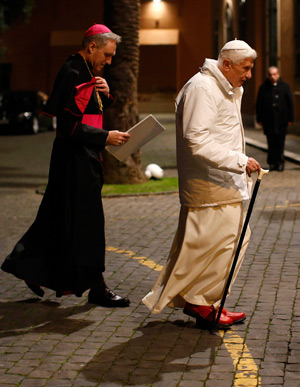VATICAN CITY (CNS) — The current staff of the papal apartments, including Archbishop Georg Ganswein, will accompany Pope Benedict XVI to Castel Gandolfo when he leaves office Feb. 28, the Vatican spokesman said.

Jesuit Father Federico Lombardi, Vatican spokesman, also repeated his assertion that the conclave to elect a new pope would begin sometime between March 15 and March 20.
Correcting information he had given reporters earlier, Father Lombardi said Archbishop Ganswein told him Feb. 14 that he would be living with the pope and with the consecrated laywomen who belong to the Memores Domini Association of the Communion and Liberation movement and serve as the pope’s domestic staff.
Archbishop Ganswein and the women will go to Castel Gandolfo with Pope Benedict and also will move with the pope to the Mater Ecclesiae Monastery, a building in the Vatican Gardens being remodeled for their use, Father Lombardi said.
The Vatican spokesman said Archbishop Ganswein will live with Benedict XVI but also serve the new pope as prefect of the papal household.
Asked how such a dual role could work when Father Lombardi previously had said Pope Benedict would not interfere in the papacy of his successor, the Jesuit said Archbishop Ganswein’s job is primarily one of logistics — organizing the pope’s daily schedule of meetings and audiences — and not a job that brings him into contact with other papal decisions.
By being the first pope to resign in almost 600 years, Pope Benedict opened a whole box of questions that could not be answered immediately and kept Father Lombardi busy responding to media inquiries and making his own.
As the leaders of the College of Cardinals, canon law experts and other Vatican officials worked to gain clarity or come up with practical solutions to problems never raised before, the Vatican spokesman’s daily briefings Feb. 11-14 reflected a work in progress.
The recurring question at the daily briefings has been “When will the conclave start?” Each day, Father Lombardi tells reporters that is up to the leadership of the College of Cardinals, but rules governing the election of a pope say it must begin no fewer than 15 days and no more than 20 days after the papacy is vacant. That would mean a conclave could begin between March 15 and March 20.
Some newspapers have reported individual cardinals suggesting an earlier start, he said, and some have pointed out the 15 days usually include a papal funeral and a mandatory nine days of memorial Masses.
However, the rules for the conclave are issued by a pope, only a pope can change them, “and that is unlikely,” Father Lombardi said Feb. 14. In fact, he said he asked in the Secretariat of State that morning and was told there was no commission working to draft potential changes for Pope Benedict to consider before leaving.
Asked what title Pope Benedict would use after Feb. 28, Father Lombardi had said that was a question still being studied, but it seemed to him that the most accurate title would be “bishop emeritus of Rome.”
When questioned again Feb. 14, he said it still was not clear, though many experts had been voicing their opinions in the media. One thing is certain, he said, “being a bishop is a result of a sacrament,” and that cannot be taken from the pope.
“Being a cardinal, on the other hand, is a title, not the effect of a sacrament, and so it has a different kind of value or importance,” he said.
In addition, he said, Benedict XVI “is his name … and that won’t change.”
Asked if there would be a public ceremony for the breaking of Pope Benedict’s fisherman’s ring, Father Lombardi said he believed the act — the responsibility of Cardinal Tarcisio Bertone as chamberlain of the Holy Roman Church — would take place in private, as it does after a pope dies.
Asked if Pope Benedict would receive a pension, Father Lombardi said a retirement fund had not been set up, “but obviously he will be taken care of.”
Asked if Pope Benedict would continue wearing the white papal cassock, the spokesman said he doubted that, since the white robes have a symbolic significance in the popular imagination.
— By Cindy Wooden Catholic News Service





